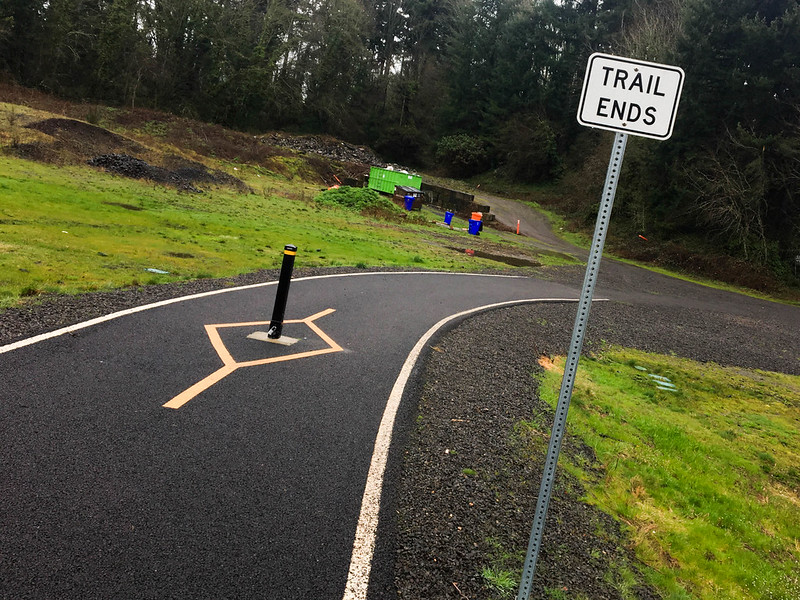
This post was written by a BikePortland subcriber.
“I feel like Portland is losing its way… Things aren’t connected.”
As a daily bike commuter and a long time road cyclist in places with pretty horrid biking conditions, riding in Portland has generally been great in contrast when I’m out riding by myself or my fellow roadie friends. Since March, however, I’ve been training for the Cycle Oregon weekend rides with my two teens, ages 17 and 13. And as our rides have started stretching out into 40-50 miles and we’ve started collaborating on where to go ride, all of us are noticing The Gaps.
— The Gap on SE 17th at the southern Portland city limits.
— The Gap on SE 17th (again) where it crosses McLoughlin into Sellwood.
— The Gap on the SW Waterfront trail near The Old Spaghetti Factory.
— The Gap on the Gresham-Fairview Trail where you need to cross the road, then turn left on to Burnside, to continue north on the MUP.
— The Gap in Lake Oswego from where the path through Tryon Creek ends and Old River Road begins (we hate that gap the most because it forces us on the narrow sidewalk, where none of us want to be).
Advertisement
We’re not asking for separated infrastructure everywhere we ride. (Though as an aside, my bike/road savvy kids always request rides on MUPs wherever possible, even if it means a longer or more roundabout trip. I’m still mulling over what that means.) But we do certainly notice where we abruptly go from having bike lanes to having nothing and/or being forced into weird detours across/against car traffic or over railroad tracks or choosing between sharing a lane on a highway or riding on the sidewalk.
I feel like Portland is losing its way in the ability to create viable non-car transportation alternates. Things aren’t connected. We manage and ride because we love it (and because if my kids want to get somewhere they have to ride, because I’m not driving them!), but we’re committed. What about all those people that think how much fun it would be to ride to lunch at Old Spaghetti Factory (or Edgefield) but then are turned off by all the weird detours Just For Them? As the State is passing a tax on the transportation mode we should be do everything to encourage rather than penalize, the penalty is a double whammy because the funds will not be allocated to fix the gaps in our street network and, I’m afraid, will just create more paths to nowhere.
— by Carrie (@CLeonard46), a BikePortland subscriber. Browse more Subscriber Posts here.


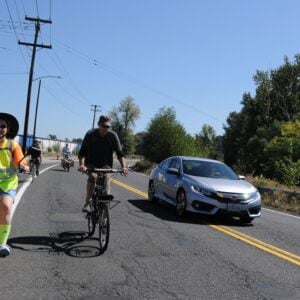
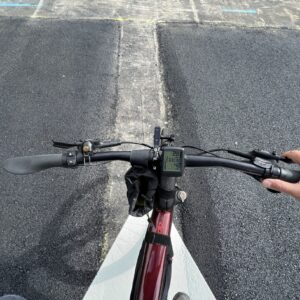
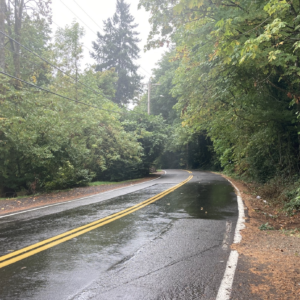
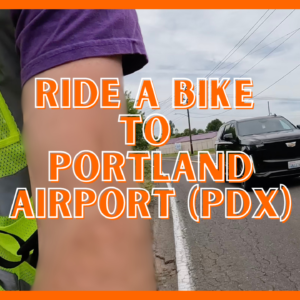
Thanks for reading.
BikePortland has served this community with independent community journalism since 2005. We rely on subscriptions from readers like you to survive. Your financial support is vital in keeping this valuable resource alive and well.
Please subscribe today to strengthen and expand our work.
“I feel like Portland is losing its way in the ability to create viable non-car transportation alternates. ”
Has that been/is that official policy?
Connectivity of hospitable routes all over seems like a viable goal, but I also think it would be worth exploring the larger framing – what it is we/PBOT are striving for, because to me that is the part that never sees the light of day, or is too often unhelpfully shrouded in mystery.
Is the decline of automobility factored into the way PBOT charts a course into the future? Are bikes recognized as an alternative mode of transport? What are they doing to realize that? Does PBOT take the 25% by 2030 (if that is the right number) mode split seriously? And if not, why not?
Some good questions in here. I’m not going to pretend I can tackle them all. The question that needs an answer is “are bikes recognized as an alternative mode of transport?” However more than that the follow up needs to be answered as well, which is simply, for whom?
For all of the bike lanes, MUPs, greenways, temporary protected lanes, and other bicycle infrastructure there has been no demonstrated desire to connect it. By that I mean, when there are opportunities to close a gap in a way that makes sense for cyclists the solution is typically some form of a roundabout path, a non-intuitive route, or simply telling people that it’s short and they can take the lane.
If the desired demographic is 20-50 year old men then I guess this works and the mode split if you broke it down based on age band and gender probably shows this (I don’t have a source handy). However my kids aren’t riding on the road I do, nor is my SO, nor are most of my friends who do not have the same affinity for cycling that I have developed. Riding out of SW you can’t really go anywhere without hitting a gap. Capitol Hwy is a minefield, Beaverton-Hillsdale loses its lanes at the Washington County border, Barbur is well documented. However the rest of the city is really no better, bike lanes disappear in favor of free parking throughout the city, larger throughfares are off limits or at the very least highly risky.
Here’s a great case in point. Last week Jonathan posted a story about new bike lanes on Lombard (https://bikeportland.org/2017/06/27/first-look-buffered-bike-lanes-on-lombard-in-north-portland-233005). While this was a move by ODOT this was a wonderful story except for the part where there is a gap of about a block between the new lanes and the existing ones so it’s now a path to nowhere unless you want to take the lane. This piecemeal approach which values lane miles over true connectivity is not going to increase mode share in any substantive way.
BH Highway has some 2 foot wide painted lines on BH Highway between the county line at SW 65th up to the Wells Fargo Bank / Noodles pasta. However, adjacent Raleigh Hills has three neighborhood routes that parallel SW Scholls Ferry Road / BH Highway. The managers of the repave of BH Highway by the Hayhurst neighborhood said last week that the bike lanes will be painted early this month. One of the stencils was painted by SW 45th late last week.
Maybe city and metro policy should be oriented toward connecting a protected network, with whatever temporary/quick means and removing parking or 4th/3rd lanes as necessary. If we had continuous safe bikeways for major corridors, riding would be more convenient and people would do it. We should now be figuring out how to make this happen by 2020, not continuously revisiting plans for “10 years away.”
Regardless how good the bike infrastructure is, there are going to be real limits how much car travel even can be replaced with bikes.
Most people do not have the fitness, desire, or time to go more than modest distances and there are real logistical issues if you’re hauling stuff, kids, if you’re sick, or a number of other things are at play.
Once you throw in some weather, even places that have quite a few cyclists in the summer have very few. Even in the perfect weather we’ve been enjoying lately, the much ballyhooed Better Naito has light bike traffic — definitely fewer bikes than cars.
If the weather is great, people don’t have far to go, they don’t need to haul anyone or anything of significance, and bike infrastructure is good, some people will use bikes some of the time.
“there are going to be real limits how much car travel even can be replaced with bikes”
Your perspective is captive to a static view of how things are *today* but elide the far more interesting and important dynamic view of how this can and likely will change going forward as the boundary conditions that make automobile dominance possible. We once experience travel that did not (yet) rely on the automobile, and we will again. The point is to figure out how to make it possible, how to facilitate the transition, rather than registering how impossible or limited the (current) alternative necessarily is.
Liking this response so much. Just because a mode doesn’t work for all people all the time does not mean that it can’t work for some or most people much of the time.
Give people some infrastructure that makes it feel safe for short trips and incentives that make it seem reasonable and people will trade their car for a bike or a bus. Over time the habit or not using a car for every little trip will form, people will recognize the benefits that make it reasonable for them and their usage will grow. Of course if we keep subsidizing cars and taxing bikes (or their purchase) then it’s not going to work so well.
Right.
And the fact that the places of Portland that have awesome bike infrastructure have hardly any actual cyclists when conditions aren’t good is only proof they’ve been brainwashed by car culture.
Where is this awesome bike infrastructure? There might be a road or two but most of the great stuff links up with junk or nothing. It’s not like the infrastructure is designed with destinations in mind.
I’m on the Ankeny Greenway pretty much every day, which is nicer with the new speed bumps and diverter, but there are serious problems with the intersection at Sandy (supposedly being fixed in the next few years) to even get on/off and I changed my route to avoid Chavez at Ankeny because it’s such a pain to cross. These little things take “awesome bike infrastructure” and convert it to something closer to alright.
Do you not ride Portland at all? There are bike lanes and greenways all over the place as well as separated paths. Yes, there are places where it’s not great, but the overall situation is excellent.
If people calling themselves cycling advocates are perpetually come up with excuses for why they can’t ride in one of the easiest areas of the country, why do you think people who either don’t care or outright don’t want to cycle will suddenly change their outlook on life because of a few separated paths?
No need to get personal. I ride almost 20 miles a day throughout this city and your description is quite generous. There are at least a dozen pain points on this route where connections are either non-existent or very poor, this isn’t including infrastructure where there are parked cars on the right of the bike lane with moving cars on the left, or pavement in poor condition, or pavement that becomes a lake during the rainy months among other things.
The goal is not to create excuses, it’s to point out the deficiencies so they can be fixed. If we allow poor connections to exist without complaint that is exactly what we will end up with. Let’s not also forget that infrastructure varies widely depending on where you are around the city. Please bike through SW sometime and let me know how wonderful it is, with the vast network of protected bikeways and greenways. Just because inner SE is well connected does not make North Portland well connected too, this is not a transitive property.
“the overall situation is excellent”
While I too have no trouble getting around on a bike, I think you are forgetting one of the things I’ve learned from hanging around here for a while: lots of folks who bike or would like to bike more are not comfortable in situations that you and I might take in stride. You can chide them, berate them, scoff at them or you can appreciate that to actually make progress with the population we have rather than clones of you and me we could do better, should do better.
I’m not saying we shouldn’t do better. We should look for opportunities. And I totally agree the infrastructure is very unevenly deployed, though I think the consistent focus in this blog reinforces rather than rectifies that imbalance.
But the constant drumming about how much things suck and that’s why people don’t ride convinces drivers and would be cyclists alike that they can’t ride.
If you want people riding, you need to help people see why they’d want to do it. No one wants constant battle with cars, death, etc. Much more attractive are stories like Abby’s guest post on her Joyride. You’ll notice in the pic she’s on a rural highway with gravel shoulders. Traffic was undoubtedly light, but cars were also undoubtedly going over 50.
Her article isn’t about her feelings of helplessness due to being at the mercy of machines of death or the terror of having cars go by at speed. Rather, she talks about what a great experience it is and recommends it for riders of all levels of experience.
A 14 year old girl saying she had a great time riding with her friends sounds a lot more motivating for getting out and riding than the constant handwringing here about how awful it is.
While we’re struggling with reality, how about convincing people who call themselves “road users” actually riding on roads like cyclists in other towns have always been doing?
The Gap in Lake Oswego? Do you mean State Street (Highway 43)? Terwilliger Blvd was just repaved near the state park, but no official bike lanes will be added there. For riding from near Burlingame Bikes store to West Linn, try the crosswalk at Foothills Road to Oswego Pointe Drive (by the backside of the Starbucks parking lot).
Rick,
That’s what we do. Come down the MUP alongside Terwilliger, then we ride 3 blocks on Hwy 43, then we hop on the sidewalk, cross at a crosswalk at Foothill, then ride on sidewalk to Leonard St to eventually get to Old River Road. It sucks. We’re on bikes — we’re not supposed to be on the sidewalk and using crosswalks. When I’m by myself or with other like-minded riders I just ride on Hwy 43 (State St), taking the lane, and turning left onto Leonard St using the left turn lane. But it’s amazingly different riding with the kids — while I find the “drivers that don’t know how to drive with a bike on the road” interactions there annoying by myself, it’s really scary when I’m with my kids.
It is lame that the new developments at A Street at State Street did not build bike lanes of any kind when they were built around 15 years ago.
Also, the gap in the multi-use path at the Mt Hood Ave MAX stop on your way to the airport. It’s the only gap between Oregon City and PDX.
Lake Oswego would benefit from a connector between the end of the Tryon MUP and Foothills park. There’s such a nice path along Foothills park that dead ends before George Rogers park because 3 houses there did not permit it to cross their backyards/river access, even though they don’t look like they use the river.
My son started riding his bike around town at 15 y/o. Learning how to ride on city streets, not being limited to trails and MUPs, is an important skill. We rode together, I showed him how to spot dangers and ride defensively, we worked out good routes for where he needed to go, I made sure his bike was lit up like a Christmas tree and that he turned on those lights. This did cause me more worry than if he only rode on MUPs and sidewalks. But you can’t avoid riding on streets in traffic forever. Once you leave the bubble that is Portland and a handful of other cities, you either ride on streets or not at all.
I guess my post makes it sound like he only started riding at 15 . . . he’s been riding since 5, rode his bike to middle school but that was only several blocks away, rode his first century at 13 . . . But it wasn’t until 15 that he needed to ride across town, cross bridges, through downtown, etc during rush hour . . . so he did it.
There’s nothing “excellent” about the infrastructure in much of east Portland. It’s a car dominated hell.
Agreed that significant areas have been neglected. The laser focus on the core and well-served areas doesn’t help nor does expending huge amounts of energy identifying flaws in the latest measures taken to improve things.
As an example, there was recently an article on Lombard on BP. It just so happens I ride this area with some regularity — most recently yesterday.
The improved area is way better than the sections before or after it. But rather than acknowledge that, the comments were filled with the predictable whining about how this measure comes up so short. The improved area is only a few blocks long. Seems like it would be better to focus on the parts of Lombard that have no bike lanes whatsoever (or another area of town with the same problems or worse). But for some reason, a huge chunk of the PB crew likes to dink around with places that probably need help the least.
Here is the question that should be asked. Why are we adding car lanes/miles when bike/walking miles are missing/in disrepair?
Until that is the true test, all other discussions are just about fighting for table scraps.
To disrepair I would add encoachment. Anyone else notice that the MUP along 26 has now gotten narrower with the addition of the electronic readerboards that are being installed? And while not permant, the COP sewer project along THPRD’s Fanno Creek MUP has at times closed the trail completely, sent riders on a detour, or restricted passage. It was scheduled to be reopened a month ago but is still obstructed by a chain link fence and the path passes over a plastic plate. There is no indication when the obstacles will be removed.
The $25,000,000 sewer project on the Fanno Creek Trail bulldozed a home and it should be finished by late summer. I’ve been asking ODOT to plant more shrubs and vegetation along the MUP path by West Slope on Highway 26.
that gap at Chimney Park to Marine Drive will oneday soon see a new bridge over Columbia Blvd ( a very active freight route..) into the ‘St Johns Prairie’, the former landfill. With a bridge over the slough and rework of the existing ‘Port of Portland trail’,connection to Marine Drive. Upon completion of this segment, one can ride from Kelly Point to Cathedral Park. It is a segment of the North Portland Willamette Greenway Trail, the ‘signature trail’ promised in the 2030 Portland Bike Master Plan. Which I must remind folks, is only 13 years from end date. The npGreenway trail is SUPPOSED to extend from the Steel Bridge, through Swan Island and on to Cathedral Park and on to Kelly Point. Completion of the Cathedral Park to Kelly Point is low hanging fruit. Portland Parks has the job to see the project to completion. My question is – can they and will they? Failure to deliver a signature trail in the time frame is a failure.
And sadly, there are so many more gaps to address. I once was taught a disconnect between what you say and what you do is a ‘gap’.
When I moved here four years ago I couldn’t understand how/why people were ‘complaining’ about the bike infrastructure, because compared to where I moved from, Portland is still excellent. However, I’ve come to realize that what we’ve got here is only because people persistently advocate for it — that the car culture here is as strong as elsewhere, but for whatever reason the voices for the alternate are often loud enough to get the infrastructure we have.
So while many view the posters of BP as complainers and we should just be quiet and be happy for what we have, I see these posters as the advocates who keep pushing for better and aren’t willing to settle for the status quo. Because if we settle, we will be drowned out by the car-centric vision of our society as a whole. So yes, I can ride 50 miles with my kids regularly and it’s amazing. But I can also advocate to have those full 50 miles with connected bike infrastructure (or heck, the 2.5 miles from my house to the high school!), even though both are better than any of the cycling in many other places.
To disrepair, i might upload encroachments. everyone else word that the MUP along 26 has now gotten narrower with the addition of the electronic readerboards which might be being mounted? And even as no longer permit.